 If you asked an attendee at last week’s Association of National Advertisers’ (ANA) “Masters of Marketing” conference, “What was the highlight for you?” the answer was almost always, “I really liked P&G’s presentation on purpose-driven marketing.” To equate it to the data-driven, digital advertising world, as buzz goes, purpose-driven marketing (PDM?) is the new demand-side platform (DSP).
If you asked an attendee at last week’s Association of National Advertisers’ (ANA) “Masters of Marketing” conference, “What was the highlight for you?” the answer was almost always, “I really liked P&G’s presentation on purpose-driven marketing.” To equate it to the data-driven, digital advertising world, as buzz goes, purpose-driven marketing (PDM?) is the new demand-side platform (DSP).
That said, purpose-driven marketing isn’t that new, but perhaps its open articulation is. And, as the demand-side platform world merges and melds into other models like ad networks and agencies, purpose-driven marketing will continue to remain in the brand marketer’s playbook as overloaded consumers require more transparency, and less b.s. from brands and their products.
Proctor & Gamble’s Global Marketing Officer Mark Pritchard said in a sharp, well-rehearsed, 20-30 minute presentation that his mega-brand corporation has moved from “the selling products business to the business of improving life” – and, oh yes, the benefit of improving lives is selling product. Marketing, baby! Even P&G’s own corporate site does not do justice to the change which P&G marketing appears to be trying to affect.
The Five Keys To Purpose-Driven Marketing
P&G’s Pritchard identified for the audience the five key changes that his company is making in how it markets its brands through purpose-driven marketing. (You can view a video clip on the ANA site.) The following quotes are from Pritchard’s presentation:
- Defining Purpose – “It starts with each brand brand defining its purpose. We expect every one of our brands to be guided by a purpose that defines how it uniquely touches and improves lives. We think of it as the soul of the brand…”
- Reinforcing The Brand’s Core Benefit – “…And that purpose springs from and reinforces the essence of the brand’s core benefit. So at the end of the day, while people will buy into a purpose, they buy a benefit…”
- Serving People With Brands – “But, the great thing about a purpose is that it can open up new possibilities to deliver that benefit to consumers. It means shifting our mindset from marketing to serving. That means changing from marketing to people – so we get them to do what we want them to do which is buy our products – to serving people with our brands to make their lives better. And that can take many forms: of course, it’s better products; but it’s also non-product services; it’s entertainment that brings people together; and it’s acts of kindness and generosity that have them part of the larger community…
- Insights On People – “It also means thinking of who we serve as people. Now this may seem obvious, but when we have a mindset of marketing to consumers, it leads to a focus of getting them to try to do what we want them to do: consume our products. But, when we focus on serving people, we’re forced to gain a deeper understanding about their whole lives and give them what they want to make their entire life better. And when we focus on serving people, we uncover human insights. Not product insights. Deep human insights that define the essence of human behavior. They represent universal human truths, motivations and tensions that must be solved by the benefits of our brands. And from these insights we create big ideas…”
- The Big Idea – “Big ideas are the currency of our industry. Big ideas have to lift the entire brand and make it relevant in people’s lives. Lift the entire brand -and not just the product initiatives that we’ve proliferated over the course of the last 10 years. Big ideas that our so engaging and surprising that they invite people to participate in our brand communities and that can take many forms from word-of-mouth advocacy and PR, to passing along YouTube videos, to engaging fans on Facebook, to getting on the website, to making a donation to charity, and, of course, participation means purchase. The key is that people become personally associated with the brand and the become loyal members of the community, and even ambassadors.
As Alan Adamson points to on Forbes, below is a big-budget example of what P&G describes as purpose-inspired, benefit-driven marketing as part of the company’s sponsorship of last year’s Vancouver Olympics. In the commercial, P&G positions its enterprise brand to make life better for moms (purpose) with all of its products (the benefits: clothes are cleaner, the diapers keep the baby drier, prevent cavities, etc.).
And just so we’re clear, P&G’s Old Spice man is purpose-driven, too. It’s not all tears and Kleenex with purpose-driven marketing. For Old Spice –
- Purpose: Man up.
- Benefit: Don’t smell like a man.












